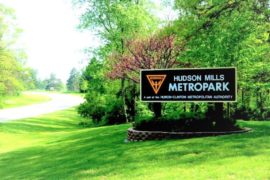Leading a nationwide trend in community concern for habitat loss, Washtenaw County has been officially designated an NWF Community Wildlife Habitat by the National Wildlife Federation (NWF). The “Washtenaw Wilderness Community Wildlife Habitat” is the first county in Michigan to receive this distinction.
A Community Wildlife Habitat project creates multiple habitat areas in backyards, schoolyards, corporate properties, community gardens, parkland and other spaces. The Washtenaw Wilderness includes 400 homes, 42 common areas, and 12 schools in Washtenaw County that are certified as NWF Community Wildlife Habitats.
Mary Lapp, founder of the Washtenaw Wilderness and an NWF volunteer, coordinated a group of community partners that spearhead the effort to designate both Washtenaw County and the City of Ann Arbor as Community Wildlife Habitats (CWH). The motto of the Washtenaw Wilderness is “Anyone can create habitat.”
The Washtenaw Wilderness group included Natural Areas Preservation (NAP) — City of Ann Arbor; Washtenaw County Parks and Rec.; Wild Ones — Ann Arbor Chapter; Washtenaw Audubon Society; Washtenaw County Commission (Rep. Yousef Rabhi); NWF Great Lakes Regional Center; “America’s Nature Guy” (Peter Schriemer); Creating Sustainable Landscapes LLC; the Thurston Nature Area; and the Ann Arbor Wolfpack. A formal ceremony designating Washtenaw County as CWH was held during the Huron River Day Festival.

“In 2013, I learned about the NWF Community Wildlife Habitat (CWH) Program, and it appealed to me because it offers a hands-on way for ordinary people to become a part of the solution to habitat destruction,” said Lapp. “The program is designed to be accessible to anyone, regardless of their level of awareness about the precarious existence of many of our native species. Participation can be as simple as adding a birdbath to your balcony garden, or it can be more comprehensive, like replacing acres of lawn with a native prairie.”
NWF’s Certified Wildlife Habitat program has been helping people take personal action on behalf of wildlife for 45 years. The program engages homeowners, businesses, schools, churches, parks and other institutions that want to make their communities wildlife-friendly.
“The Community Wildlife Habitat program was a terrific platform for introducing children to nature and our role in protecting it, but it also has been a touchstone for changing the predominant cultural perception that conservation is a sacrificial service,” continued Lapp. “When community members make small changes on their properties to benefit wildlife, such as growing native wildflowers, not using pesticides, keeping their cats indoors, or leaving the trunk of a dead hardwood tree for animals to use, we are all rewarded with greater opportunities for interaction with the natural world in our daily lives.”
The Community Wildlife Habitat project is part of NWF’s Garden for Wildlife program. These projects benefit the entire community of plants, wildlife, and people through the creation of sustainable landscapes that require little or no pesticides, fertilizers, and excess watering. These landscapes help keep water and air resources clean. They are healthier for people and the environment, and are less resource-dependent than conventional landscapes. Habitat landscapes can serve to beautify our urban areas and give residents pride in their neighborhoods.
Lapp says, “My grandmother, Mary Shaul, introduced me to the concept of wildlife conservation by taking me on nature walks and teaching me to identify the birds, animals, and wildflowers that were native to the area. Growing up in the Water Hill neighborhood of Ann Arbor, I saw fox sparrows at our feeder, swallowtail butterflies and northern walking sticks crossed our lawn, and several native species of violets and ferns appeared behind our house every spring. Today, finding these species in a backyard in Washtenaw County is far less commonplace. I knew my neighbors and friends would want to be part of turning that trend around.”
NWF commends the dedicated residents of Washtenaw County and the Washtenaw Wilderness team for their wildlife conservation efforts and for coming together for a common purpose — to create a community where people and wildlife can flourish. At a time when communities are faced with the problems of losing habitat to development, Washtenaw County stands out as a model for other communities to emulate. The knowledge and inspiration that this project has generated will lead County residents and visitors to take better care of their natural world.
“Providing a home for wildlife in our cities — whether it’s at home, or in schools, businesses or parks — is the demonstration of a healthy and active eco-system. There is no more rewarding way to stay connected to nature right outside your door,” said David Mizejewski, naturalist with the National Wildlife Federation.
To date, 107 cities have been recognized with Community Wildlife Habitat certification. Since 1973, NWF has provided more than 7 million people with the basic guidelines for making their landscapes more wildlife-friendly. There are more than 217,000 certified habitats nationwide. For more information, please go to: www.nwf.org/garden.
To learn more about the Washtenaw Wilderness, listen to this episode of WEMU’s Issues of the Environment: http://wemu.org/post/issues-environment-establishing-washtenaw-wilderness












